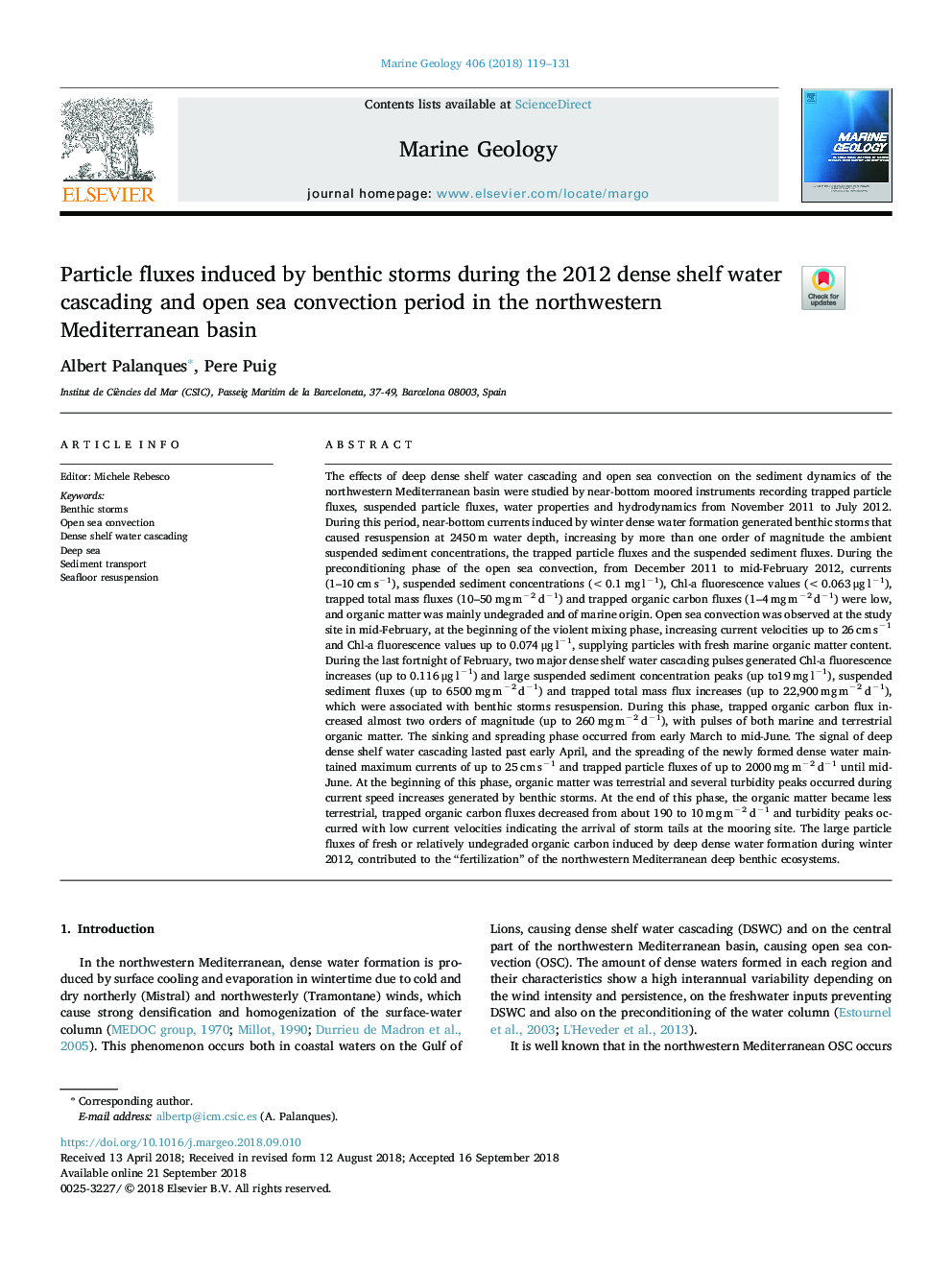| کد مقاله | کد نشریه | سال انتشار | مقاله انگلیسی | نسخه تمام متن |
|---|---|---|---|---|
| 10997912 | 1355078 | 2018 | 13 صفحه PDF | دانلود رایگان |
عنوان انگلیسی مقاله ISI
Particle fluxes induced by benthic storms during the 2012 dense shelf water cascading and open sea convection period in the northwestern Mediterranean basin
ترجمه فارسی عنوان
شار ذرات ناشی از طوفان های بتس در طی دوره آبشار سیلاب کم عمق و دوره باز شدن دریای باز در حوضه دریای شمال غربی
دانلود مقاله + سفارش ترجمه
دانلود مقاله ISI انگلیسی
رایگان برای ایرانیان
موضوعات مرتبط
مهندسی و علوم پایه
علوم زمین و سیارات
ژئوشیمی و پترولوژی
چکیده انگلیسی
The effects of deep dense shelf water cascading and open sea convection on the sediment dynamics of the northwestern Mediterranean basin were studied by near-bottom moored instruments recording trapped particle fluxes, suspended particle fluxes, water properties and hydrodynamics from November 2011 to July 2012. During this period, near-bottom currents induced by winter dense water formation generated benthic storms that caused resuspension at 2450â¯m water depth, increasing by more than one order of magnitude the ambient suspended sediment concentrations, the trapped particle fluxes and the suspended sediment fluxes. During the preconditioning phase of the open sea convection, from December 2011 to mid-February 2012, currents (1-10â¯cmâ¯sâ1), suspended sediment concentrations (<0.1â¯mgâ¯lâ1), Chl-a fluorescence values (<0.063â¯Î¼gâ¯lâ1), trapped total mass fluxes (10-50â¯mgâ¯mâ2â¯dâ1) and trapped organic carbon fluxes (1-4â¯mgâ¯mâ2â¯dâ1) were low, and organic matter was mainly undegraded and of marine origin. Open sea convection was observed at the study site in mid-February, at the beginning of the violent mixing phase, increasing current velocities up to 26â¯cmâ¯sâ1 and Chl-a fluorescence values up to 0.074â¯Î¼gâ¯lâ1, supplying particles with fresh marine organic matter content. During the last fortnight of February, two major dense shelf water cascading pulses generated Chl-a fluorescence increases (up to 0.116â¯Î¼gâ¯lâ1) and large suspended sediment concentration peaks (up to19â¯mgâ¯lâ1), suspended sediment fluxes (up to 6500â¯mgâ¯mâ2â¯dâ1) and trapped total mass flux increases (up to 22,900â¯mgâ¯mâ2â¯dâ1), which were associated with benthic storms resuspension. During this phase, trapped organic carbon flux increased almost two orders of magnitude (up to 260â¯mgâ¯mâ2â¯dâ1), with pulses of both marine and terrestrial organic matter. The sinking and spreading phase occurred from early March to mid-June. The signal of deep dense shelf water cascading lasted past early April, and the spreading of the newly formed dense water maintained maximum currents of up to 25â¯cmâ¯sâ1 and trapped particle fluxes of up to 2000â¯mgâ¯mâ2â¯dâ1 until mid-June. At the beginning of this phase, organic matter was terrestrial and several turbidity peaks occurred during current speed increases generated by benthic storms. At the end of this phase, the organic matter became less terrestrial, trapped organic carbon fluxes decreased from about 190 to 10â¯mgâ¯mâ2â¯dâ1 and turbidity peaks occurred with low current velocities indicating the arrival of storm tails at the mooring site. The large particle fluxes of fresh or relatively undegraded organic carbon induced by deep dense water formation during winter 2012, contributed to the “fertilization” of the northwestern Mediterranean deep benthic ecosystems.
ناشر
Database: Elsevier - ScienceDirect (ساینس دایرکت)
Journal: Marine Geology - Volume 406, 1 December 2018, Pages 119-131
Journal: Marine Geology - Volume 406, 1 December 2018, Pages 119-131
نویسندگان
Albert Palanques, Pere Puig,
